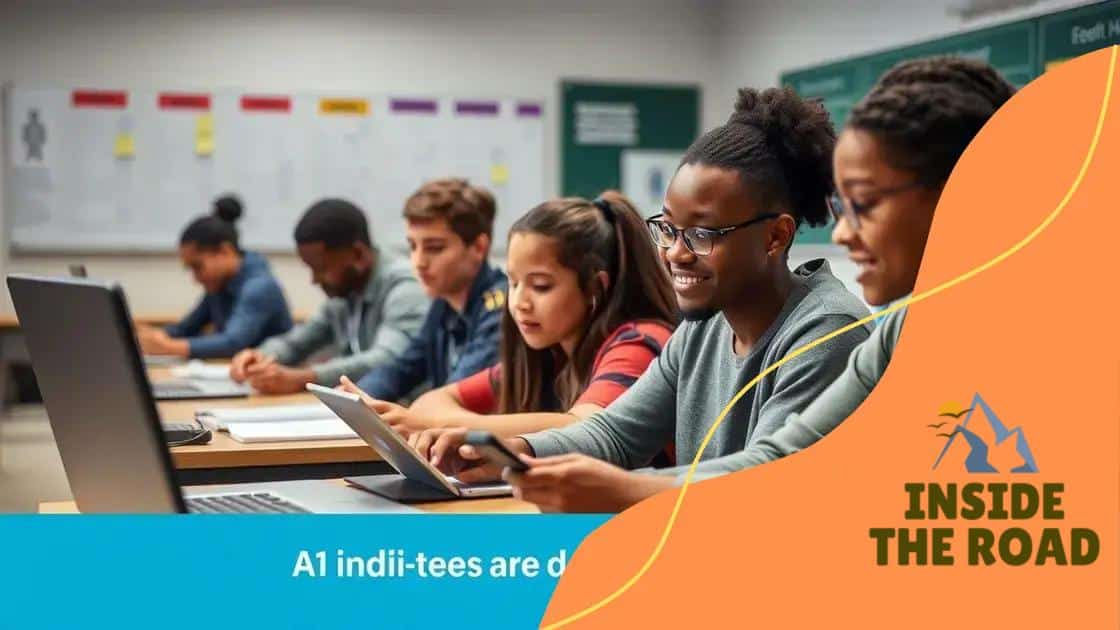AI-powered assessments for student performance tracking

AI-powered assessments revolutionize education by personalizing learning experiences, providing real-time feedback, and enhancing efficiency, while ensuring student data privacy and supporting educators with valuable insights.
AI-powered assessments for student performance tracking are becoming increasingly popular in educational settings. Have you ever wondered how these technologies can transform learning? Let’s dive in and explore their impact.
understanding AI in educational assessments
Understanding AI in educational assessments can revolutionize how we evaluate student performance. By integrating AI technologies, educators can gain deeper insights into students’ learning processes. This allows for more personalized teaching methods that cater to individual needs.
What is AI in Education?
AI in education includes machine learning, data analytics, and natural language processing, all designed to enhance the learning experience. It helps create assessments that are not just tests, but tools for learning. With AI, we can analyze a student’s strengths and weaknesses quickly.
Benefits of Using AI in Assessments
Using AI in assessments offers several advantages:
- Increased efficiency by automating grading tasks.
- Real-time feedback for students to improve their understanding.
- Customized learning paths based on student performance.
- More accurate and objective evaluations that minimize bias.
Furthermore, traditional methods often fail to capture a full picture of a student’s abilities. With AI-powered assessments, data from multiple sources help educators identify trends and gaps in knowledge.
AI systems can adapt questions based on students’ responses, ensuring that they are challenged appropriately. This flexibility encourages a more engaging learning environment and motivates students to perform better.
benefits of AI-powered performance tracking
The benefits of AI-powered performance tracking are transforming education. By using AI, schools and teachers can monitor student progress in real-time, allowing for more personalized learning experiences. This technology helps educators see not only how students are performing but also what they need to improve.
Enhanced Tracking and Reporting
With AI, tracking student performance becomes easier and more efficient. Traditional assessment methods can be time-consuming and sometimes unreliable. In contrast, AI provides:
- Instantaneous feedback to students and teachers.
- Detailed analytics that highlight student strengths and weaknesses.
- A comprehensive view of student engagement and participation.
- The ability to identify at-risk students early on.
This level of insight is invaluable for educators aiming to support every student’s unique learning journey.
Personalized Learning Experiences
AI-powered systems allow for tailored learning strategies, which can significantly benefit students. These systems can adapt to each student’s learning pace. For example, if a student struggles with a particular topic, the AI can suggest additional resources and practice questions, ensuring that no one falls behind.
Moreover, AI-powered performance tracking can motivate students by providing them with achievable goals and milestones. As they track their progress, they gain a sense of accomplishment. This creates a positive feedback loop that encourages further learning.
In conclusion, the integration of AI into performance tracking not only aids educators but also empowers students. It creates a collaborative learning environment where everyone can thrive.
how AI changes traditional assessment methods

AI is changing traditional assessment methods in significant ways. With the introduction of AI technologies, educators can now administer assessments that are more efficient and effective. The traditional one-size-fits-all approach to testing is evolving into a more customized experience.
Customizable Assessments
One major way AI changes assessments is through customization. AI algorithms can analyze a student’s previous performance and tailor questions that fit their specific needs. This means assessments become more relevant, challenging the student appropriately based on their skills.
- Adaptive scoring systems can provide instant feedback.
- Students receive questions suited to their knowledge level.
- Results help identify specific areas needing improvement.
- Dynamic assessments keep students engaged.
By adapting questions in real-time, AI ensures that each student feels challenged but not overwhelmed. This personalization leads to a better understanding of material.
Efficiency in Grading
Another significant change is the efficiency AI brings to grading. Manual grading can be a tedious process, consuming valuable time for educators. AI can quickly and accurately grade assessments, allowing teachers to focus on more meaningful interactions with students.
This efficiency doesn’t only save time; it also improves accuracy in grading. AI systems can minimize human errors while providing insights into overall student performance. With this data, teachers can make informed decisions about instructional strategies.
Lastly, the ability to track performance over time is enhanced with AI. Traditional assessments often provide a snapshot of knowledge at one point in time. AI enables continuous assessment, allowing educators to see growth and trends throughout the learning process.
real-world examples of AI in education
Real-world examples of AI in education showcase how this technology is changing the learning landscape. Schools and institutions across the globe are implementing AI tools to enhance teaching and student engagement.
AI Tutors and Assistants
One of the most notable examples is the use of AI tutors. Programs like Knewton adapt to individual student needs. These AI systems can provide personalized learning experiences, offering resources and practice tailored to each learner’s level. They also give instant feedback, helping students improve more effectively.
- AI tutors help students understand complex subjects like math and science.
- They encourage self-paced learning, allowing students to progress as they master each concept.
- Many students report increased confidence in their abilities when using AI tutoring tools.
Automated Grading Systems
Another example is automated grading systems, such as Gradescope. These systems allow educators to grade assignments quickly and accurately using AI algorithms. This technology saves time and ensures consistency across assessments.
Moreover, schools are using AI to analyze student performance data. Tools like IBM Watson Education help educators evaluate trends in student data to improve curriculum design and instructional strategies. This enables teachers to better support their students based on solid evidence.
In addition, platforms like Duolingo utilize AI to adapt language learning exercises. They create a customized experience, helping learners practice language skills in a way that feels engaging and effective.
considerations for implementing AI assessments
Implementing AI assessments in education comes with various considerations that educators need to keep in mind. As schools begin to adopt these technologies, it is essential to evaluate their impact carefully. Understanding how to integrate AI effectively can enhance learning outcomes.
Data Privacy and Security
One of the foremost concerns is data privacy. Schools must ensure that student data is protected when using AI systems. Establishing strong data security measures is crucial to prevent unauthorized access and misuse of information.
- Choose AI tools that comply with regulations like FERPA.
- Implement encryption methods to secure sensitive data.
- Educate staff and students about data privacy practices.
Training for Educators
Training educators on how to use AI assessments effectively is vital. Without proper training, teachers may struggle to integrate these systems into their teaching practices. Offering professional development programs can help educators maximize the benefits of AI.
Moreover, teachers should be involved in the selection process of AI tools. Their insights can guide necessary features to support student learning effectively. Integration relies on teacher input and awareness of student needs.
Balanced Approach
It’s also essential to maintain a balanced approach to assessments. While AI provides valuable data, it should not fully replace traditional methods. A combination of AI and conventional assessments can offer a more comprehensive view of student performance.
Carefully selecting when to use AI assessments can help ensure they complement existing methods. This balance allows educators to gain insights while still incorporating their expertise in evaluating student understanding.
FAQ – Frequently Asked Questions about AI in Education
How can AI assessments personalize learning for students?
AI assessments adapt to individual student needs by providing customized questions and resources based on their performance.
What are the privacy concerns associated with AI in education?
Privacy concerns include the protection of student data and ensuring compliance with regulations to prevent misuse.
How can educators effectively use AI tools in the classroom?
Educators can effectively use AI tools by undergoing proper training and actively participating in the selection of these technologies.
What is the importance of balancing AI assessments with traditional methods?
Balancing AI with traditional methods allows for a more comprehensive evaluation of student performance, incorporating both quantitative and qualitative insights.






